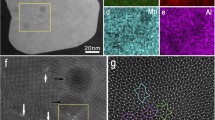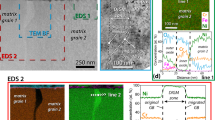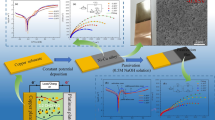Abstract
Corrosion destroys more than three per cent of the world's GDP1. Recently, the electrochemical decomposition of metal alloys has been more productively harnessed to produce porous materials with diverse technological potential2,3. High-resolution insight into structure formation during electrocorrosion is a prerequisite for an atomistic understanding and control of such electrochemical surface processes. Here we report atomic-scale observations of the initial stages of corrosion of a Cu3Au(111) single crystal alloy within a sulphuric acid solution. We monitor, by in situ X-ray diffraction with picometre-scale resolution, the structure and chemical composition of the electrolyte/alloy interface as the material decomposes. We reveal the microscopic structural changes associated with a general passivation phenomenon of which the origin has been hitherto unclear. We observe the formation of a gold-enriched single-crystal layer that is two to three monolayers thick, and has an unexpected inverted (CBA-) stacking sequence. At higher potentials, we find that this protective passivation layer dewets and pure gold islands are formed; such structures form the templates for the growth of nanoporous metals2. Our experiments are carried out on a model single-crystal system. However, the insights should equally apply within a crystalline grain of an associated polycrystalline electrode fabricated from many other alloys exhibiting a large difference in the standard potential of their constituents4, such as stainless steel (see ref. 5 for example) or alloys used for marine applications, such as CuZn or CuAl.




Similar content being viewed by others
References
Koch, G. H., Brongers, M. P. H., Thompson, N. G., Virmani, Y. P. & Payer, J. H. Corrosion Cost and Preventive Strategies in the United States. Report FHWA-RD-01-156 (Report by CC Technologies Laboratories, Inc. to Federal Highway Administration (FHWA), Office of Infrastructure Research and Development, McLean, 2001); http://www.corrosioncost.com/pdf/main.pdf.
Erlebacher, J., Aziz, M. J., Karma, A., Dimitrov, M. & Sieradzki, K. Evolution of nanoporosity in dealloying. Nature 410, 450–453 (2001)
Weissmüller, J. et al. Charge-induced reversible strain in a metal. Science 300, 312–315 (2003)
Al-Kharafi, F. M., Ateya, B. G. & Allah, R. M. Selective solution of brass in salt water. Appl. Electrochem. 34, 47–53 (2004)
Williams, D. E., Newman, R. C., Song, Q. & Kelly, R. G. Passivity breakdown and pitting corrosion of binary alloys. Nature 350, 216–219 (1991)
Gerischer, H. in Korrosion Vol. 14 (ed. Heumann, T.) 59–64 (Chemie, Weinheim, 1962)
Pickering, H. W. Characteristic features of alloy polarization curves. Corr. Sci. 23, 1107–1120 (1983)
Kaiser, H. & Eckstein, G. A. in Corrosion of Alloys—Encyclopedia of Electrochemistry (eds Stratmann, M. & Frankel, G. S.) Vol. 4, 156–186 (Wiley, Weinheim, 2003)
Oppenheim, I. C., Trevor, D. J., Chidsey, Ch. E. D., Trevor, P. L. & Sieradzki, K. In-situ scanning tunnelling microscopy of corrosion of silver-gold alloys. Science 254, 687–689 (1991)
Chen, S. J. et al. Selective dissolution of copper from Au-rich Cu-Au alloys: an electrochemical study. Surf. Sci. 292, 289–297 (1993)
Eckstein, G. A. In-situ Rastertunnelmikroskopische Untersuchungen zur selektiven Korrosion von niedrigindizierten Au 3 Cu(hkl) und Cu 3 Au(hkl) Legierungseinkristallen. Dissertation, Erlangen (2001).
Stratmann, M. & Rohwerder, M. A pore view of corrosion. Nature 410, 420–423 (2001)
Moffat, T. P., Fan, F.-R. F. & Bard, A. J. Electrochemical and scanning tunneling microscopic study of dealloying of Cu3Au. J. Electrochem. Soc. 138, 3224–3235 (1991)
Kabius, B., Kaiser, H. & Kaesche, H. in Surfaces Inhibition and Passivation (eds McCafferty, E. & Brodd, R. J.) 562–573 (The Electrochemical Society, Pennington, 1986)
Li, R. & Sieradzki, K. Ductile-brittle transition in random porous Au. Phys. Rev. Lett. 68, 1168–1171 (1992)
Pickering, H. W. & Swann, P. R. Electron metallography of chemical attack upon some alloys susceptible to stress corrosion cracking. Corrosion 19, 373t–389t (1963)
Forty, A. J. Corrosion micromorphology of noble metal alloys and depletion gilding. Nature 282, 597–598 (1979)
Forty, A. J. & Rowlands, G. A. Possible model for corrosion pitting and tunneling in noble metal alloys. Phil. Mag. A 43, 171–188 (1980)
Pickering, H. W. Formation of new phases during anodic dissolution of Zn-rich Cu-Zn alloys. J. Electrochem. Soc. 117, 8–15 (1970)
Robinson, I. K. & Tweet, D. J. Surface X-ray diffraction. Rep. Prog. Phys. 55, 599–651 (1992)
Zoubov, N., Vanleugenhage, C. & Pourbaix, M. in Atlas d'Equilibres Electrochemique (ed. Pourbaix, M.) Ch. 14 (Gauthier Villars, Paris, 1963)
Erlebacher, J. An atomistic description of dealloying. J. Electrochem. Soc. 151, C614–C626 (2004)
Stierle, A. et al. Dedicated Max-Planck beamline for the in-situ investigation of interfaces and thin films. Rev. Sci. Instrum. 75, 5302–5307 (2004)
Fleischmann, M. & Mao, B. W. In-situ X-ray diffraction studies of Pt electrode/solution interfaces. J. Electroanal. Chem. 229, 125–139 (1987)
Zegenhagen, J. et al. X-ray diffraction study of a semiconductor/electrolyte interface: n-GaAs(001)/H2SO4/(:Cu). Surf. Sci. 352–254, 346–351 (1996)
Vlieg, E. ROD: a program for surface X-ray crystallography. J. Appl. Crystallogr. 33, 401–405 (2000)
Acknowledgements
We thank B. Krause, A. Reicho, S. Warren, B. C. C. Cowie, S. Thiess, O. Bunk and W. Drube for their help with the synchrotron measurements, and F. D'Anca and R. Felici for collaboration in developing the in-situ cell and installing the electrochemistry laboratory at INFM-OGG/ESRF. The Bundesministerium für Forschung und Bildung (BMBF) is acknowledged for financial support.
Author information
Authors and Affiliations
Corresponding author
Ethics declarations
Competing interests
Reprints and permissions information is available at npg.nature.com/reprintsandpermissions. The authors declare no competing financial interests.
Rights and permissions
About this article
Cite this article
Renner, F., Stierle, A., Dosch, H. et al. Initial corrosion observed on the atomic scale. Nature 439, 707–710 (2006). https://doi.org/10.1038/nature04465
Received:
Accepted:
Issue Date:
DOI: https://doi.org/10.1038/nature04465
- Springer Nature Limited
This article is cited by
-
Insight on the Dynamics of Corrosion and Anti-Corrosion Protection Progresses on Steel: A Brief Review
Journal of Bio- and Tribo-Corrosion (2024)
-
Dynamic imaging of interfacial electrochemistry on single Ag nanowires by azimuth-modulated plasmonic scattering interferometry
Nature Communications (2023)
-
Exploring the Corrosion Behavior of Low-Ni Cu-P-Cr-Ni Weathering Steel with Different P Contents in a Simulated Atmospheric Environment
Journal of Materials Engineering and Performance (2023)
-
Random forest incorporating ab-initio calculations for corrosion rate prediction with small sample Al alloys data
npj Materials Degradation (2022)
-
Cross-linking and silanization of clay-based multilayer films for improved corrosion protection of steel
Journal of Materials Science (2022)





